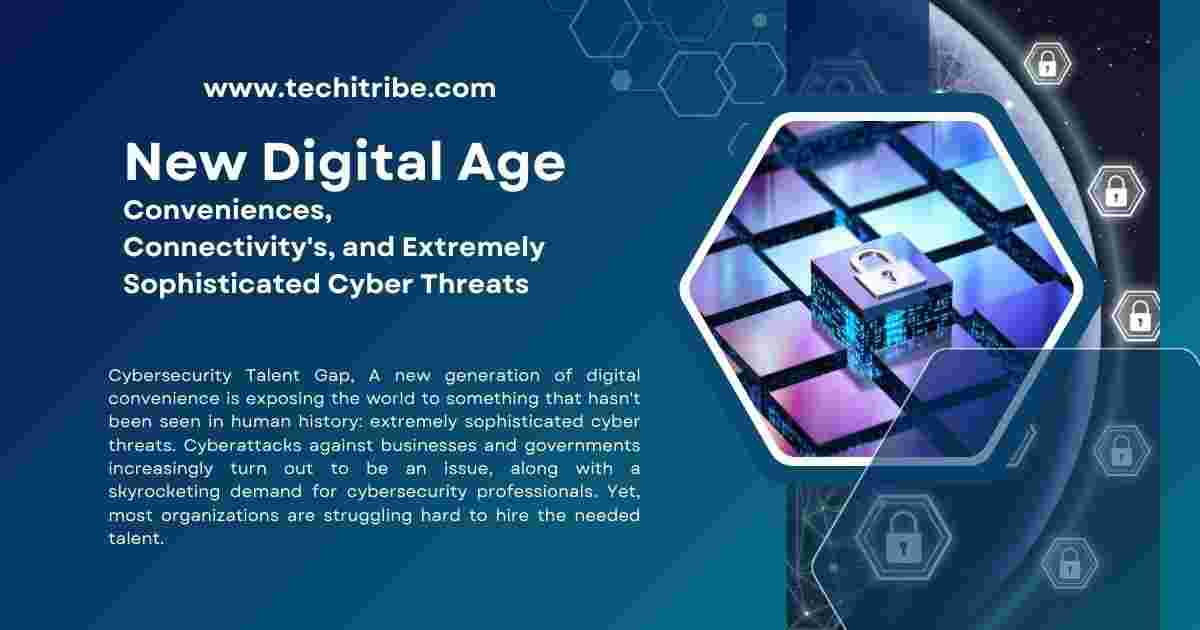Cybersecurity Talent Gap With the world being hyper connected, cybersecurity has never been so rapt, as now the number of breaches, cyber attacks and digital vulnerabilities are on the rise. The industry of cybersecurity has drastically increased the need for highly skilled professionals in cybersecurity; however, this state of affairs has its own industry of cybersecurity worrying about a talent gap. The article provides very effective illumination of the present situation concerning hiring in cybersecurity, what causes it, and certain practical ways to bridge this gap.
Also Visit On This Link: Quantum-Resistant Cryptography: A Powerful Defense Against Future Cyber Threats

New Digital Age: Conveniences, Connectivity’s, and Extremely Sophisticated Cyber Threats
Cybersecurity Talent Gap, A new generation of digital convenience is exposing the world to something that hasn’t been seen in human history: extremely sophisticated cyber threats. Cyberattacks against businesses and governments increasingly turn out to be an issue, along with a skyrocketing demand for cybersecurity professionals. Yet, most organizations are struggling hard to hire the needed talent.
Cybersecurity Talent Gap Statistics
The world will need at least 3.5 million available positions in the cybersecurity workforce that are currently undersupplied
70% of cybersecurity experts believe organizations are understaffed to meet existing needs, They say
Cybersecurity Talent Gap, They are the smallest and yet they are most vulnerable target : small and medium-sized enterprises hardly able to afford incurring the expensive recruitment requirements.
All these figures present very frightening prospects for all the companies involved in all these spheres. With such colossal stakes, it entirely becomes sensible to define what can be considered the cause and how this shortage should be managed.
Why Does Cybersecurity Talent Shortage Exist?
In reality, there are a number of factors that can be pointed out as the cause for this lacking cybersecurity talent. The main drivers of the systemic fault of a permanently growing problem are:
The Threat Landscape: Cybersecurity Talent Gap, In such a fast-changing world, it goes without saying that cyber threats are changing at unprecedented speeds with new weaknesses and attack vectors found every other day. Continual knowledge updates and skills refreshes by experienced professionals will be of essence to keep pace with an increasingly changing state, but innovation is happening so fast that education and training programs fall behind a notch or two.
This has resulted in a kind of gap between skills new graduates possess and the kind of expertise organizations need.
Cybersecurity Talent Gap, A lot of complex marriage required for cybersecurity jobs; one needs technical and soft skills. There might be people who really care about cybersecurity but are really far from attaining prized certificates or degrees or hands-on experience. For example, a turning points like CISSP or CEH tends to become quite pricey as well as time-consuming, which limits who cannot afford it.
3. Low Awareness and Education
Cybersecurity Talent Gap, Not even this part of cyber touches the students at an early stage of their lives. That way, most students coming into higher education are unaware of the fact that indeed careers in cyber security do exist, and that gives a strained pipeline. Colleges also lack specially designed cyber security programs or experts as faculty members, which again hits the count of people trained.
4. Cybersecurity professionals experience burnout due to stress.
Cybersecurity Talent Gap, Cybersecurity is a very demanding and deadly profession because most of the hours go under great pressure, which lowers professionalism. There is a high burnout, and most cybersecurity professionals leave the field or take up other less demanding jobs. This churn rate aggravates the talent gap crisis at a time when the demand increases faster than the industry can retain the professionals.

Approaches that Should Fill Cybersecurity Talent Gap
Cybersecurity Talent Gap, To fill the cybersecurity talent gap through industry cooperation, education reform, and new approaches toward recruitment are very necessary. Among them, those mentioned here have proven to be some of the most important differences that can make a difference in bridging the cybersecurity talent gap:
1. Improve awareness regarding cybersecurity and availability in education.
Introduce Cybersecurity Concepts to the Toughest Extents a Student Can Attain: The young students can be interested and conscious with cybersecurity concepts introduced up to the most tremendous levels a student can achieve. Hence, security courses offered at higher levels of education in STEM will be shown more to the students.
Partnership with Educational Institutions
Industry-academic collaborations can also be made to have more relevance. The firms can make workshop and internship arrangements involving job training for the students. Cybersecurity boot camps and certification courses will be apt completions of a degree, wherein the student acquires skills immediately relevant to him, but within a much shorter period than what is going to take in the traditional degree program.
2. Diversify the Source of Talent by Recruiting Non-Typical Sources
Next is the issue of companies having to look elsewhere in order to bridge that gap. An example is that people will have a career background, including IT, software development, and even law enforcement, and therefore bring much-needed diversity to the workforce.
Set up Veterans and Career Changers Support
The other growth in the cybersecurity workforce is through training for reskilling veterans or even those who might want to have a career change. For instance, qualities such as great discipline, technological competencies, and being adaptable are qualities that veterans possess; hence, it is ideal to work in cybersecurity.
3. Continuous Process Through Professional Development
Such threats require the presence of expert cyber security professionals all the time. From the list above, it implies that organizations can encourage more employees to go for training by providing reimbursement of certificate fees, sponsoring cyber security events, and participating in cyber security competitions, among other plans.
Mentorship and Peer Learning
The retention of the employees is through the mentorship programs that enable the transfer of feelings from veterans to novices. Almost minimal levels of turnover are reduced and shared and retained information regarding cyber security within the organizations.
4. Counteracts Burnout and Mental Health
Support with regard to mental health and well-being is easily and thus often avoided through ensuring that cyber teams do not burn out. Examples include flexible hours, work days that one can utilize toward his or her mental well-being, and realistic work expectations. Companies that do this find to have more resilient teams with a supportive culture of work, which results in higher retention rates and thus an enhanced, engaged workforce.
5. Cybersecurity Diversity and Inclusion
Cybersecurity diversity is no buzzword. It reflects an entirely new way of thinking of many problems that need to be solved and even prompts innovation. In being an organization, more increase in diversity is the key thing for it to be more inclusive with more women, people of color, and persons from other socioeconomically diverse backgrounds.

Gender and Culture Incorporation
Proactive recruiting policies with a focus on diversity can retain the underrepresented groups. Scholarship, networking, and mentoring programs to attract communities of minority groups are broadly encompassed by effective methods of building a diverse cybersecurity workforce.
Role of the Government and Policymakers
The regulatory agencies also have critical contributions in this regard. Policies as well as funding for the training programs can create a dynamic pipeline of skilled professionals.
Government-funded Funded Training Programs
There have been several measures taken over the past decade, or more, by various governments to arrest recent cyber warfare talent deficits. Among those, probably most salient are cybersecurity apprenticeships and federally funded cyber education to get those who cannot pursue more conventional modes of education prepared.
Governmental sanction by the authoritative body to adopt industry standards and best practices has only provided that organizations cannot afford to play lip service to the idea of cybersecurity training, which has generated a demand for the skilled person concerned.
The governmental media campaigns can obviously make masses aware of this rewarding career in cybersecurity.
How Companies Can Stay Secure in the Age of Talent Shortage: Moving Forward
While the cybersecurity talent gap is a serious challenge, there are certain things that organizations can do to feel safe despite it. In fact, while most organizations are investing in technology, including automation and AI-driven threat detection, the organization will rely less on manual monitoring while burden continues to decrease for cybersecurity teams .
Work with Third-Party Security Providers
The MSSP would thus play a role like that of a life preserver for such firms that are suffering from a shortage of skills. During the short term, security outsourcing by professionals would undoubtedly become an essential gap filler during the period of growth of skills from within.
Safe Passage to the Next Step MSSPs
Security Maturity CONTENTS
Building the Security Mindset
This makes every employee responsible for cybersecurity; hence, an organization will create a security-first culture. Training programs on cybersecurity, along with time-to-time threat and vulnerability updates and also best security practices, can make cybersecurity everyone’s responsibility and not just the bunch of dedicated teams.
Conclusion: The First Step into a Sustainable Cybersecurity Future
Indeed, it is by filling the cybersecurity talent gap that a secure digital future will be built. What is needed to fill this shortage is a collective effort by educators, employers, governments, and cybersecurity in the aggregate. Industry-wide proactive efforts to grow the pool of available talent and augment public awareness and opportunities to help professionals do their jobs will do a great deal toward closing the talent gap and building a strong, well-trained workforce.
Cybersecurity initiatives wisely embarked upon would, over time, lead to a good, stable cybersecurity workforce. However, such efforts pay tribute and acknowledge paces directions towards a more secure digital world for all.
